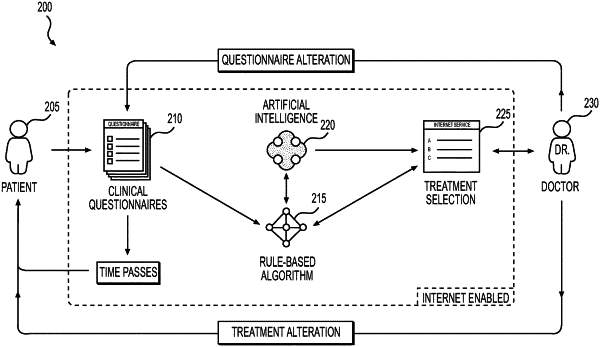| CPC G16H 50/20 (2018.01) [G06N 5/022 (2013.01); G06N 20/00 (2019.01); G16H 10/20 (2018.01); G16H 10/60 (2018.01); G16H 20/10 (2018.01); G16H 20/70 (2018.01); G16H 50/70 (2018.01)] | 20 Claims |

|
1. A system for predicting a treatment efficacy for a patient, the system comprising:
at least one processor, and memory storing a plurality of executable instructions which, when executed by the at least one processor, cause the system to:
train a machine learning algorithm (MLA) by:
receiving datasets from one or more sources corresponding to treatments for mental illness, wherein each data point in the datasets comprises questionnaire data corresponding to a patient and an indication of treatment efficacy corresponding to the respective patient;
normalizing results of the datasets, thereby generating normalized results;
generating, based on the normalized results, a training dataset;
selecting one or more features in the training dataset;
training, using the selected one or more features, the MLA to predict, for input patient data, an efficacy of each of a plurality of treatments; and
training the MLA to determine a prototype corresponding to the input patient data from a set of prototypes, wherein each prototype of the set of prototypes corresponds to a cluster of patient data, wherein the training is performed using a loss function, wherein the loss function determines a distance between prototypes, and wherein the loss function determines a variance in remission predictions between the prototypes,
predict the treatment efficacy for the patient by:
receiving questionnaire responses from the patient;
inputting the questionnaire responses into the MLA;
outputting, by the MLA, a predicted efficacy of each of the plurality of treatments for the patient; and
outputting, by the MLA, a prototype of the set of prototypes corresponding to the patient,
generate, based on the predicted efficacy of the one or more treatments and the prototype, an interface, and
output for display the interface.
|